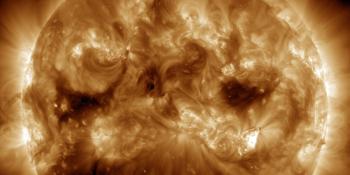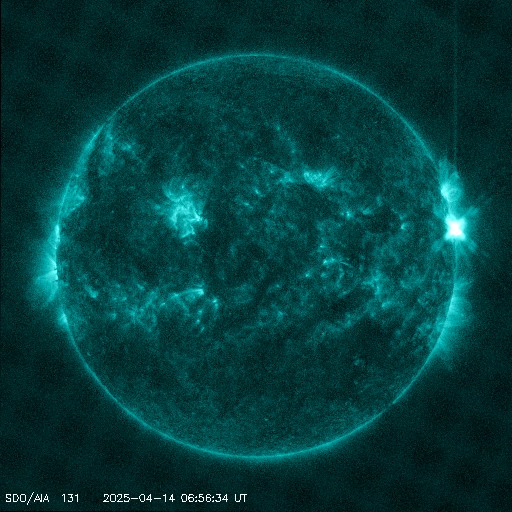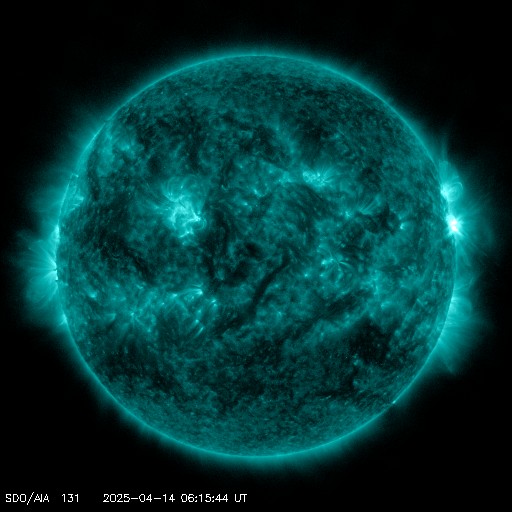Viewing archive of Friday, 29 May 2020
Daily bulletin on solar and geomagnetic activity from the SIDC
Issued: 2020 May 29 1234 UTC
SIDC Forecast
Solar flares
C-class flares expected, (probability >=50%)
Geomagnetism
Active conditions expected (A>=20 or K=4)
Solar protons
Quiet
| 10cm flux | Ap | |
|---|---|---|
| 29 May 2020 | 069 | 011 |
| 30 May 2020 | 070 | 018 |
| 31 May 2020 | 070 | 010 |
Bulletin
The active region that is still in the process of rotating to the visible side of the Sun was source of several B-class flares during last 30 hours. The same region was this morning also the source of C 9.3 GOES flare (peaked at 10:46 UT) and M 1.1 flare (peak at 07:24 UT). We can expect more C-class flares and possibly also isolated M-class flares in the coming hours. The coronagraph observation of the CMEs possibly associated with the C-class and M-class flares are not yet available. However, as the source region is still partially on the back side of the Sun, the possibly associated CMEs will not be Earth directed. During last 24 hours proton flux levels were at background values and are expected to remain so.
The Earth is still inside the slow solar wind with the speed of about 290 km/s. The interplanetary magnetic field magnitude is rather stable and it amounts about 4 nT. The solar wind originating from the extension of the southern polar coronal hole that crossed central meridian on May 25 might be expected later today or tomorrow morning. It might be closely followed by the solar wind originating from the small and patchy equatorial coronal hole (negative polarity) that reached central meridian on the midday of May 27. On May 30 we can also expect the arrival of the CME-driven shock wave associated with rather faint CME (observed above the west solar limb early on May 26). The geomagnetic conditions are quiet and we expect quiet to possibly active geomagnetic conditions in the next 24 hours.
Today's estimated international sunspot number (ISN): 000, based on 31 stations.Solar indices for 28 May 2020
| Wolf number Catania | /// |
| 10cm solar flux | 068 |
| AK Chambon La Forêt | 007 |
| AK Wingst | 004 |
| Estimated Ap | 003 |
| Estimated international sunspot number | 000 - Based on 38 stations |
Noticeable events summary
| Day | Begin | Max | End | Loc | Strength | OP | 10cm | Catania/NOAA | Radio burst types |
|---|---|---|---|---|---|---|---|---|---|
| 29 | 0713 | 0724 | 0728 | ---- | M1.1 | --/---- | III/2 |
Provided by the Solar Influences Data analysis Center© - SIDC - Processed by SpaceWeatherLive
All times in UTC
Current data suggests there is a slight possibility for aurora to appear at the following high latitude regions in the near future
ReykjavikLatest news
Latest forum messages
Support SpaceWeatherLive.com!
A lot of people come to SpaceWeatherLive to follow the Sun's activity or if there is aurora to be seen, but with more traffic comes higher server costs. Consider a donation if you enjoy SpaceWeatherLive so we can keep the website online!

Latest alerts
Monday, 14 April 2025
23:15 UTC - Geomagnetic activity
Active geomagnetic conditions (Kp4) Threshold Reached: 23:01 UTC
07:09 UTC - Solar flare
Moderate M4.28 flare from sunspot region 4055
06:48 UTC - Radio Blackout
Minor R1 radio blackout in progress (≥M1 - current: M1.53)
06:24 UTC - Solar flare
Moderate M1.49 flare from sunspot region 4055
06:06 UTC - Radio Blackout
Minor R1 radio blackout in progress (≥M1 - current: M1.16)
Space weather facts
| Last X-flare | 2025/03/28 | X1.1 |
| Last M-flare | 2025/04/14 | M4.2 |
| Last geomagnetic storm | 2025/04/06 | Kp5 (G1) |
| Spotless days | |
|---|---|
| Last spotless day | 2022/06/08 |
| Monthly mean Sunspot Number | |
|---|---|
| March 2025 | 134.2 -20.4 |
| April 2025 | 132.1 -2.1 |
| Last 30 days | 130.6 -13.6 |





